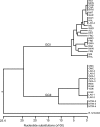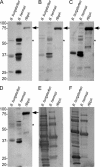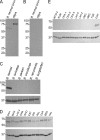A novel surface antigen of relapsing fever spirochetes can discriminate between relapsing fever and Lyme borreliosis
- PMID: 20147497
- PMCID: PMC2849321
- DOI: 10.1128/CVI.00518-09
A novel surface antigen of relapsing fever spirochetes can discriminate between relapsing fever and Lyme borreliosis
Abstract
In a previous immunoproteome analysis of Borrelia hermsii, candidate antigens that bound IgM antibodies from mice and patients infected with relapsing fever spirochetes were identified. One candidate that was identified is a hypothetical protein with a molecular mass of 57 kDa that we have designated Borrelia immunogenic protein A (BipA). This protein was further investigated as a potential diagnostic antigen for B. hermsii given that it is absent from the Borrelia burgdorferi genome. The bipA locus was amplified and sequenced from 39 isolates of B. hermsii that had been acquired from western North America. bipA was also expressed as a recombinant fusion protein. Serum samples from mice and patients infected with B. hermsii or B. burgdorferi were used to confirm the immunogenicity of the recombinant protein in patients infected with relapsing fever spirochetes. Lastly, in silico and experimental analysis indicated that BipA is a surface-exposed lipoprotein in B. hermsii. These findings enhance the capabilities of diagnosing infection with relapsing fever spirochetes.
Figures






Similar articles
-
Sequence analysis and serological responses against Borrelia turicatae BipA, a putative species-specific antigen.PLoS Negl Trop Dis. 2013 Sep 19;7(9):e2454. doi: 10.1371/journal.pntd.0002454. eCollection 2013. PLoS Negl Trop Dis. 2013. PMID: 24069498 Free PMC article.
-
GlpQ: an antigen for serological discrimination between relapsing fever and Lyme borreliosis.J Clin Microbiol. 1996 Oct;34(10):2483-92. doi: 10.1128/jcm.34.10.2483-2492.1996. J Clin Microbiol. 1996. PMID: 8880505 Free PMC article.
-
Characterization of Immunological Responses to Borrelia Immunogenic Protein A (BipA), a Species-Specific Antigen for North American Tick-Borne Relapsing Fever.Microbiol Spectr. 2022 Jun 29;10(3):e0172221. doi: 10.1128/spectrum.01722-21. Epub 2022 May 17. Microbiol Spectr. 2022. PMID: 35579456 Free PMC article.
-
Molecular biology of antigenic variation in Lyme borreliosis and relapsing fever: a comparative analysis.Scand J Infect Dis Suppl. 1991;77:88-93. Scand J Infect Dis Suppl. 1991. PMID: 1947817 Review.
-
Recombinant protein immunoblots for differential diagnosis of tick-borne relapsing fever and Lyme disease.J Vector Borne Dis. 2023 Oct-Dec;60(4):353-364. doi: 10.4103/0972-9062.383641. J Vector Borne Dis. 2023. PMID: 38174512 Review.
Cited by
-
A serological assay to detect and differentiate rodent exposure to soft tick and hard tick relapsing fever infections in the United States.Ticks Tick Borne Dis. 2023 Jul;14(4):102167. doi: 10.1016/j.ttbdis.2023.102167. Epub 2023 Mar 23. Ticks Tick Borne Dis. 2023. PMID: 36965260 Free PMC article.
-
Immunological Responses to the Relapsing Fever Spirochete Borrelia turicatae in Infected Rhesus Macaques: Implications for Pathogenesis and Diagnosis.Infect Immun. 2019 Mar 25;87(4):e00900-18. doi: 10.1128/IAI.00900-18. Print 2019 Apr. Infect Immun. 2019. PMID: 30642902 Free PMC article.
-
Detection of Tickborne Relapsing Fever Spirochete, Austin, Texas, USA.Emerg Infect Dis. 2018 Nov;24(11):2003-2009. doi: 10.3201/eid2411.172033. Epub 2018 Nov 17. Emerg Infect Dis. 2018. PMID: 30160650 Free PMC article.
-
TickPath Layerplex: adaptation of a real-time PCR methodology for the simultaneous detection and molecular surveillance of tick-borne pathogens.Sci Rep. 2019 May 6;9(1):6950. doi: 10.1038/s41598-019-43424-y. Sci Rep. 2019. PMID: 31061487 Free PMC article.
-
Novel approaches for the serodiagnosis of louse-borne relapsing fever.Front Cell Infect Microbiol. 2022 Sep 20;12:983770. doi: 10.3389/fcimb.2022.983770. eCollection 2022. Front Cell Infect Microbiol. 2022. PMID: 36204641 Free PMC article.
References
-
- Alugupalli, K. R. 2008. A distinct role for B1b lymphocytes in T cell-independent immunity. Curr. Top. Microbiol. Immunol. 319:105-130. - PubMed
-
- Alugupalli, K. R., R. M. Gerstein, J. Chen, E. Szomolanyi-Tsuda, R. T. Woodland, and J. M. Leong. 2003. The resolution of relapsing fever borreliosis requires IgM and is concurrent with expansion of B1b lymphocytes. J. Immunol. 170:3819-3827. - PubMed
-
- Alugupalli, K. R., J. M. Leong, R. T. Woodland, M. Muramatsu, T. Honjo, and R. M. Gerstein. 2004. B1b lymphocytes confer T cell-independent long-lasting immunity. Immunity 21:379-390. - PubMed
-
- Alugupalli, K. R., A. D. Michelson, I. Joris, T. G. Schwan, K. Hodivala-Dilke, R. O. Hynes, and J. M. Leong. 2003. Spirochete-platelet attachment and thrombocytopenia in murine relapsing fever borreliosis. Blood 102:2843-2850. - PubMed
-
- Barbour, A. G. 1990. Antigenic variation of a relapsing fever Borrelia species. Annu. Rev. Microbiol. 44:155-171. - PubMed
Publication types
MeSH terms
Substances
Associated data
- Actions
- Actions
- Actions
- Actions
- Actions
- Actions
- Actions
- Actions
- Actions
- Actions
- Actions
- Actions
- Actions
- Actions
- Actions
- Actions
- Actions
- Actions
- Actions
- Actions
- Actions
- Actions
- Actions
- Actions
- Actions
- Actions
- Actions
- Actions
- Actions
- Actions
- Actions
- Actions
- Actions
- Actions
- Actions
- Actions
- Actions
- Actions
- Actions
- Actions
Grants and funding
LinkOut - more resources
Full Text Sources
Other Literature Sources
Medical

